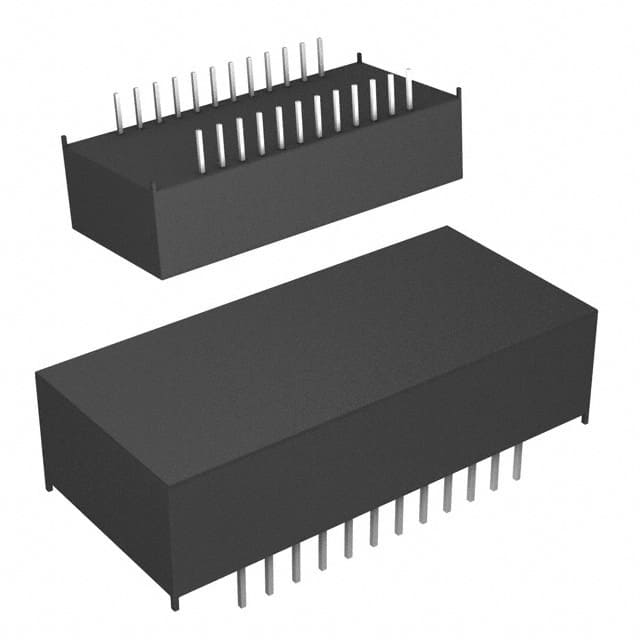DS1220AB-100+ Encyclopedia Entry
Product Overview
Category
The DS1220AB-100+ belongs to the category of non-volatile static random-access memory (NVSRAM).
Use
This product is primarily used for storing data in applications that require both non-volatility and high-speed read/write operations.
Characteristics
- Non-volatile: The DS1220AB-100+ retains stored data even when power is removed.
- High-speed operation: It offers fast access times, making it suitable for time-critical applications.
- Low power consumption: The device operates at low power levels, ensuring energy efficiency.
- Durable: With a robust design, the DS1220AB-100+ can withstand harsh environmental conditions.
Package
The DS1220AB-100+ is available in a compact and industry-standard 24-pin dual in-line package (DIP).
Essence
The essence of the DS1220AB-100+ lies in its ability to combine the benefits of non-volatile memory with the speed and ease of use of static random-access memory (SRAM).
Packaging/Quantity
The DS1220AB-100+ is typically packaged in reels or tubes, with each package containing a specified quantity of devices.
Specifications
- Memory capacity: 16 kilobits (2 kilobytes)
- Organization: 2K x 8 bits
- Operating voltage: 4.5V to 5.5V
- Access time: 100 nanoseconds
- Data retention: Over 10 years
- Operating temperature range: -40°C to +85°C
Detailed Pin Configuration
The DS1220AB-100+ features a 24-pin dual in-line package (DIP) with the following pin configuration:
- Chip Enable (CE)
- Output Enable (OE)
- Write Enable (WE)
- Address Inputs (A0-A10)
- Data Inputs/Outputs (DQ0-DQ7)
- Ground (GND)
- No Connection (NC)
- VCC
Functional Features
- Non-volatility: The DS1220AB-100+ retains data even when power is lost, eliminating the need for constant backup.
- High-speed operation: It offers fast read and write access times, enabling efficient data processing.
- Easy integration: The device can be easily interfaced with microcontrollers and other digital systems.
- Low power consumption: The DS1220AB-100+ operates at low power levels, reducing energy consumption.
Advantages and Disadvantages
Advantages
- Non-volatile storage eliminates the risk of data loss during power outages.
- High-speed operation allows for quick data retrieval and updates.
- Easy integration with existing systems simplifies implementation.
- Low power consumption reduces energy costs.
Disadvantages
- Limited memory capacity compared to other non-volatile memory options.
- Relatively higher cost per kilobit compared to traditional SRAM.
Working Principles
The DS1220AB-100+ combines the benefits of SRAM and non-volatile memory technologies. It utilizes a volatile SRAM array for high-speed read/write operations and a non-volatile electrically erasable programmable read-only memory (EEPROM) for data retention. When power is applied, the DS1220AB-100+ automatically transfers data from the EEPROM to the SRAM array, allowing fast access to stored information. During power loss, the data remains intact in the EEPROM until power is restored.
Detailed Application Field Plans
The DS1220AB-100+ finds applications in various fields, including:
- Industrial automation: Used for storing critical configuration data in programmable logic controllers (PLCs).
- Automotive systems: Employed in electronic control units (ECUs) for storing calibration data and fault codes.
- Medical devices: Utilized for storing patient data and system configurations in medical equipment.
- Aerospace and defense: Used in avionics systems for storing mission-critical data and software parameters.
Detailed and Complete Alternative Models
- DS1220AD-100+: Similar to the DS1220AB-100+, but with extended temperature range (-55°C to +125°C).
- DS1230AB-100+: Offers higher memory capacity (32 kilobits) while maintaining similar characteristics to the DS1220AB-100+.
- DS1245AB-100+: Combines non-volatile RAM with a real-time clock/calendar, suitable for applications requiring timekeeping functionality.
In conclusion, the DS1220AB-100+ is a non-volatile static random-access memory that offers high-speed operation, low power consumption, and durability. Its integration of SRAM and EEPROM technologies provides the advantages of both volatile and non-volatile memory. With various application possibilities and alternative models available, the DS1220AB-
Senaraikan 10 soalan dan jawapan biasa yang berkaitan dengan aplikasi DS1220AB-100+ dalam penyelesaian teknikal
Sure! Here are 10 common questions and answers related to the application of DS1220AB-100+ in technical solutions:
Q: What is DS1220AB-100+? A: DS1220AB-100+ is a non-volatile static RAM (NVSRAM) chip manufactured by Maxim Integrated. It combines the benefits of both SRAM and EEPROM, providing fast read/write access with non-volatile data storage.
Q: What are the key features of DS1220AB-100+? A: The key features of DS1220AB-100+ include a 256K-bit memory array, battery backup support, unlimited write cycles, low power consumption, and a wide operating temperature range.
Q: How can DS1220AB-100+ be used in technical solutions? A: DS1220AB-100+ can be used in various applications such as industrial control systems, medical devices, gaming machines, automotive electronics, and any other system that requires non-volatile data storage.
Q: Does DS1220AB-100+ require an external power supply? A: Yes, DS1220AB-100+ requires a +5V power supply for normal operation. It also has a built-in lithium energy source for battery backup during power loss.
Q: Can DS1220AB-100+ be interfaced with microcontrollers or processors? A: Yes, DS1220AB-100+ can be easily interfaced with microcontrollers or processors using standard parallel interface protocols.
Q: What is the maximum operating frequency of DS1220AB-100+? A: The maximum operating frequency of DS1220AB-100+ is typically 33 MHz, allowing for high-speed data transfer.
Q: Is DS1220AB-100+ compatible with both 3.3V and 5V systems? A: No, DS1220AB-100+ is designed for use in 5V systems only. It is not directly compatible with 3.3V systems without level-shifting circuitry.
Q: Can DS1220AB-100+ retain data during power loss? A: Yes, DS1220AB-100+ has a built-in lithium energy source that provides battery backup, allowing it to retain data even when the main power supply is disconnected.
Q: What is the typical data retention period of DS1220AB-100+? A: The typical data retention period of DS1220AB-100+ is 10 years, ensuring long-term reliability of stored information.
Q: Are there any special considerations for using DS1220AB-100+ in high-temperature environments? A: Yes, DS1220AB-100+ can operate reliably in a wide temperature range (-40°C to +85°C). However, it is important to consider proper heat dissipation and thermal management in high-temperature applications to ensure optimal performance and longevity.
Please note that these answers are general and may vary depending on specific application requirements and datasheet specifications.


